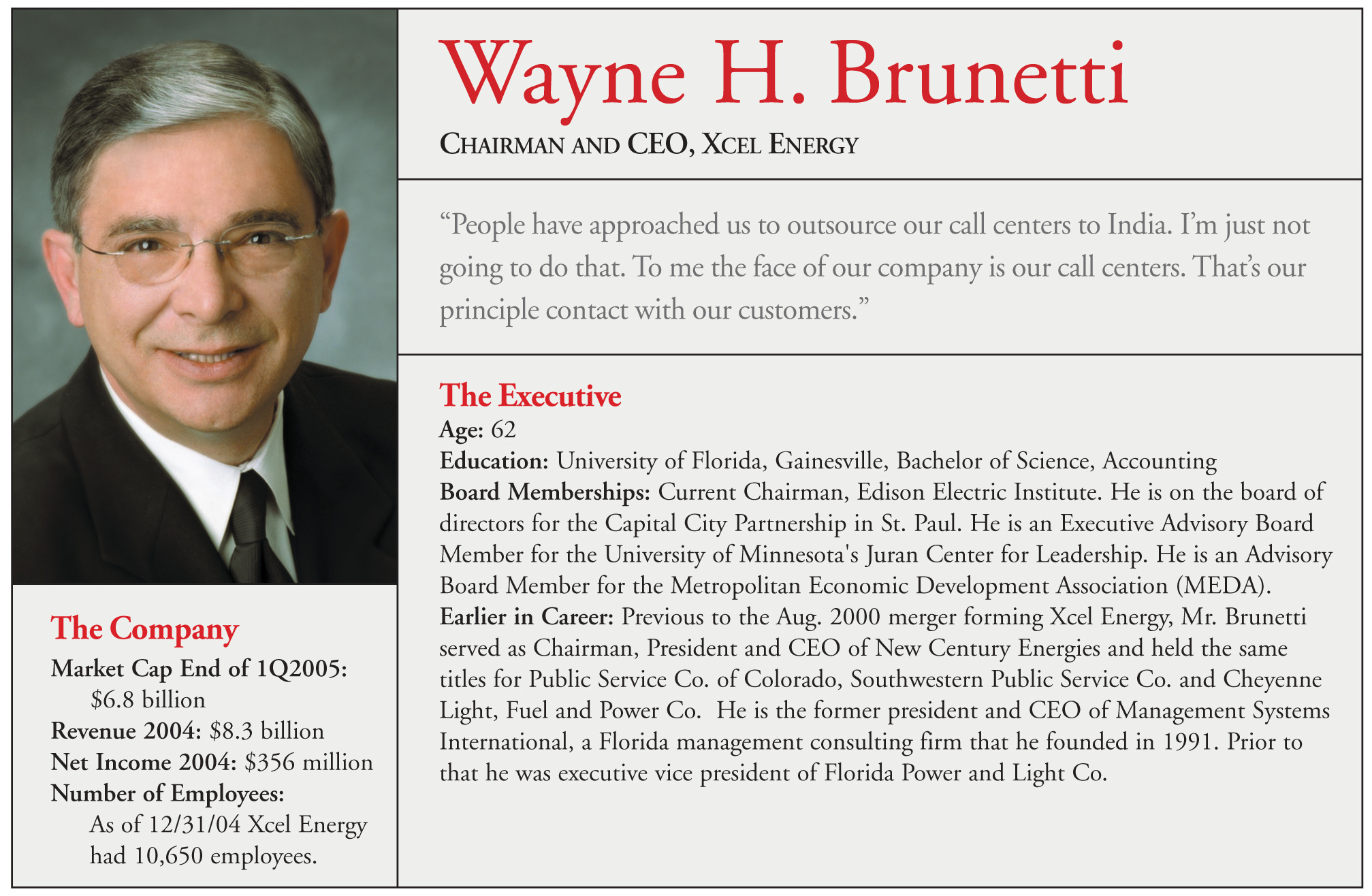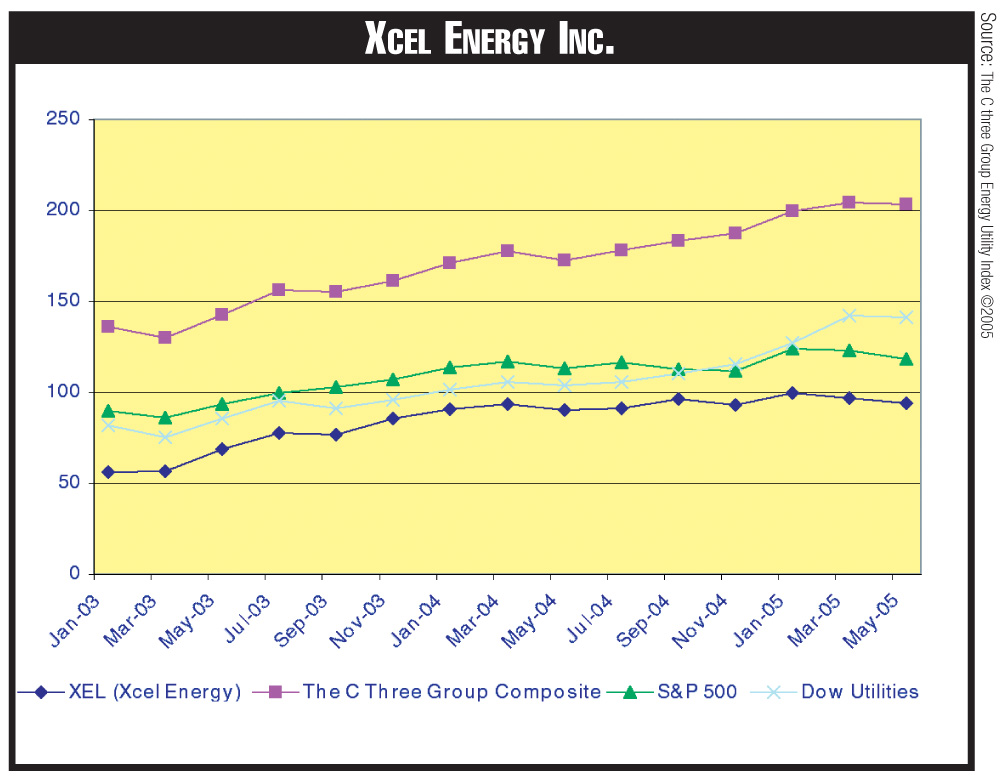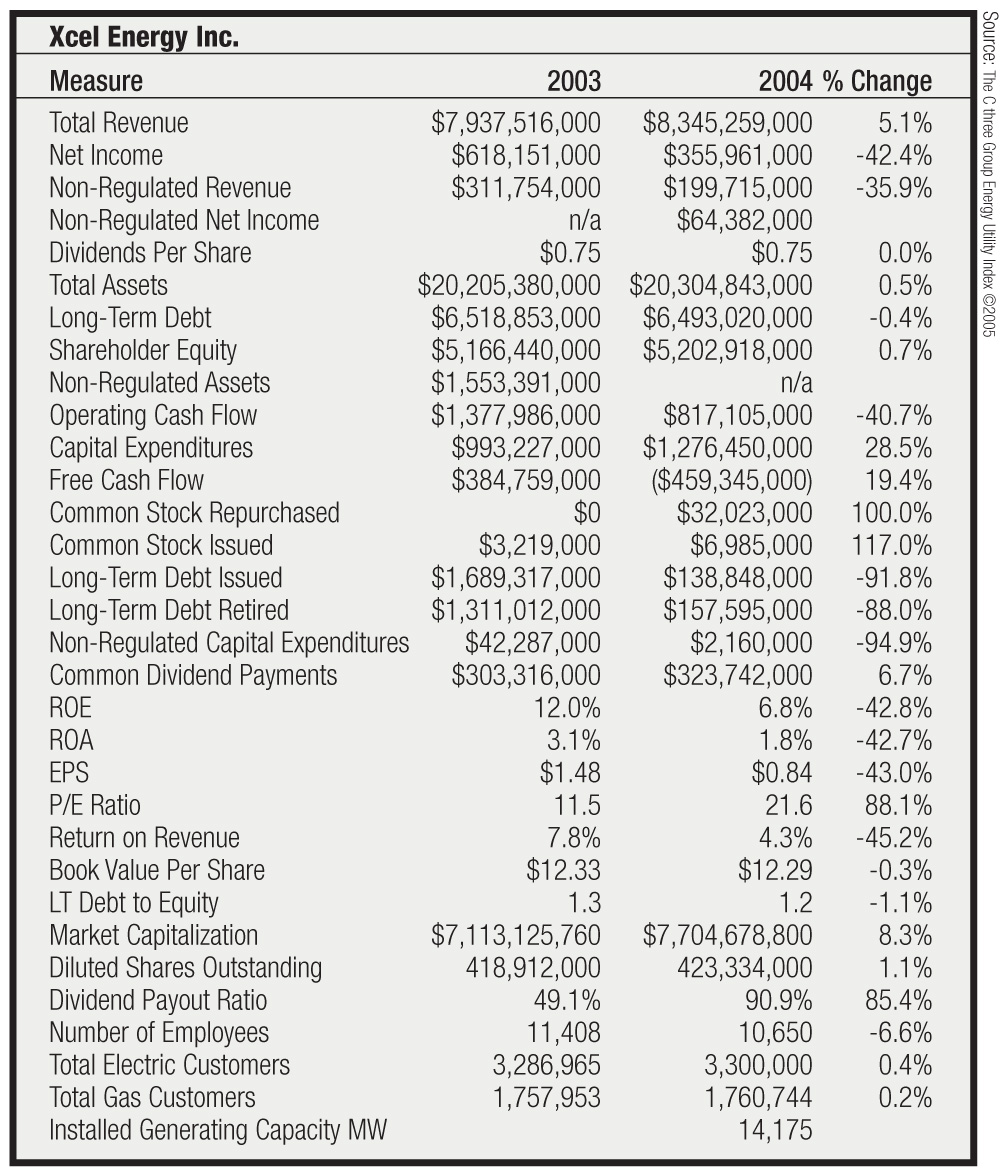The CEO Power Forum: Not all utility CEOs are created equal...



Wayne H. Brunetti
Chairman and CEO, Xcel Energy
“People have approached us to outsource our call centers to India. I’m just not going to do that. To me the face of our company is our call centers. That’s our principle contact with our customers.”
Public Utilities Fortnightly How does Xcel Energy distinguish itself from its peers?
Wayne Brunetti As you know, we have gone back to our core business … and are in the process of divesting ourselves, of virtually all of our non-electric and gas operations. Then the question becomes, where do we go from here and what do we do? Our corporate goal is to deliver a 7 to 9 percent return to our investment, [what] we believe is a low-risk strategy. We call it building the core.
We are a fully integrated utility holding company that operates four operating companies in 10 states. As a business strategy, we are not going to stray from our core regulated business. Sometimes I step back and ask the question—particularly with the movement that we had a few years ago as to a breaking up of the industry into its component parts and having competitive retail markets—why that hasn’t happened with us. I think the principal reason is that if you look at our rates compared to those states that have gone through that restructuring, our rates our relatively low compared to them.
Fortnightly How do you define the core?
Brunetti We are both an electric and gas LDC company, and our core business is selling electricity and gas. That is our core business, including the production, delivery of electricity, and only the delivery of gas. We are not in the production business on the gas side of the business. That is our core business.
Fortnightly How do you hope your business process Utility Innovations technology project will distinguish your utility from other utilities?
Brunetti If you think about the very nature of being a regulated integrated utility, one of the things that drives a lot of our thinking is providing the best service to customers. It’s kind of a simple straight-forward strategy. If you don’t keep customers happy, regulators won’t keep you happy, which in turn won’t keep investors happy.
So we start from the premise that you have to provide exceptional service to customers. That fundamentally has driven our Utility Innovations process. Many of the processes we have have been around for a long, long time, 50 years plus maybe. … I think the Utility Innovations project is one that steps back and says, “What if did something different? What if we could do something differently?”
The Utility Innovations is kind of an evolutionary process that really started back in 1996 when we decided back in the Public Service Company of Colorado to outsource out IT operations to IBM. That has evolved to what I would call a true partnership. We have probably one of the most unique contracts with IBM. I always remark that I can’t tell an IBM employee from an Xcel employee.
With that as a cornerstone, we had some other key suppliers of technology that were doing work for us. We asked the question, “What if we could get these folks together and what if they would agree to share their technology with each other to create some unique applications for our industry? And what if they would do it on their own dollars, and not our funding?” And that is what we have created.
Fortnightly What was driving this process for technological development?
Brunetti What is driving it is that we had some fast-track projects that we experimented with in Irvana, Service Center of Colorado. We saw that we could do things that were quite unique. We could reduce the time that it takes for a designer dealing with a developer and actually work with them in the field to create designs for their project while they are in the field. This [contrasts] with the old classical way of taking notes, going back and trying to do a design, and then getting back with the developer with field estimates. You can actually get field estimates right in the field instantaneously, and look at redesigns if that is appropriate. And you can look at ways at how to redeploy crews while they are in the field for changes in outages or work schedules. Or as one crew foreman told me, “If we had this online technology that I am connected to as a foreman … while I am waiting to set up another job if I am in between jobs … I can see if there is some maintenance applications that I could do in a short period of time that are there at my fingertips, I can redeploy my crews to get that done.”
Certainly, one of the things we were experimenting with is how utilities are notified of outages when a customer calls. That is how we know there is an outage, unless it is some major thing that we do know about. A good question is, “What if we could detect it before the customer called us?” So we kind of redeployed some technology that we were using in the system to be able to do that, using a fundamentally a meter that is sitting there doing its job for billing purposes that we realized could be do its job for other purposes.
Fortnightly What results do you hope to achieve from this initiative?
Brunetti There are three principle results that we are going to see from that: 1) reducing capital costs; 2) reducing operating costs; and 3) improving customer service. Anytime you can improve processes, reduce the time element in a process like restoration of service, designing new construction for a developer or home owner, as the case may be, or for a particular business. If you can compress that process in time you are going to reduce costs. You are going to reduce operating costs. You are going to reduce capital costs. And the most important element of that is that you are going to improve customer service. So, those are the three targeted areas that Utility Innovations is geared toward.
Fortnightly Why was the initial development of the technology program put on such a tight 90-day initial deadline period? What was the urgency in developing new technology?
Brunetti Some of our folks went to an [Massachusetts Institute of Technology] MIT workshop. … These were some professors and students at MIT that were working on a concept called rapid prototyping. They were saying that that the classic way of designing systems today—there’s a better way to do it. With existing technology, you could do it rapidly to get an application that’s not a production application but sort of a beta application in a very short period of time. Our folks took that concept from MIT and with out partners, said, “What we can’t afford to do is to sit down and design using the classic methods of design. It’s just too costly because we don’t know if the applications will work or not.” So, they employed this concept of rapid deployment and rapid development to get the concept down. Will it work or not? So … there were some “what if?” ideas that came about that didn’t pan out, but a bunch did pan out, and you didn’t spend a lot of money doing it, and you did it in a short period of time. You also got instant feedback, particularly from the field people. So, the concept is to try to prove a technology without trying to design what I call a production system. Once that concept is proved, then you can go into the design of a production system.
Fortnightly How does your Utility Innovations technology effort differ from Electric Power Research Institute initiatives that seek technology solutions on behalf of the utility industry?
Brunetti EPRI is working on some very important areas, particularly on things like pollution abatement and how we can improve the production of the power plant—not so much working on businesses processing—particularly with a unique group of partners that came to the table with their own money to improve their processes. Those in this partnership are certainly not in competition with EPRI for that kind of technology development. … IBM, Indus, Itron, and SPL Workgroup and a company called Mercury, they have unique software technologies, and what we have been able to do is bring them together to develop a combined use of their technologies and improve business processes.
Fortnightly What are some of the technologies you are developing?
Brunetti There are several examples. One is—and it may sound so simple but I can assure you it is something that has plagued us as an industry—workforce deployment, scheduling and optimizing the workforce to make sure that we are able to get the right jobs to the right crews at the right time; to automate the whole scheduling process of crews and redeployment of those crews using our mobile fixed network. This is what I mentioned earlier. If we can detect an outage before a customer has to call, you think about that. A phone call is an expensive operation. Then that phone call has to be relayed to dispatchers, and then the dispatchers have to deploy crews. What if you could shorten the process where we could get the detection if there is an outage ahead of time? That is automatically deployed to the crew. You are going to shorten the outage time of it and from a cost standpoint you are going to reduce costs.
Fortnightly Do you have a position on technological outsourcing? Where is the ideal point between utility operations and outsourcing?
Brunetti From a philosophical standpoint, we are not in the software business. We are in the business of providing electric and gas. When we first began this outsourcing in 1996 we were looking for a partner whose business was software. We chose IBM at the time because that is their business. Theirs is a huge business that invests in technology development in the hardware- and software-related industries. We’re not. And that is how we view things dealing with outsourcing—someone whose core business it is that does it better than we could do it.
Fortnightly There’s been discussion about outsourcing a utilities trading and asset management function. How much of utility operations can be outsourced?
Brunetti One of the things we do well is run power plants.
I don’t intend to outsource the running of our power plants. We have a great skill base in trading and I don’t intend to outsource that. We do outsource part of our human resource in the benefit areas. … But we don’t outsource anything else in that regard. When I think of the history of this industry when I came to work in 1964 in the industry, we virtually did everything. We had huge print shops. We don’t have print shops anymore; we outsourced that. … Where we are going to hire our employees and develop our employees is in the production and delivery of energy. That’s our core business and that is what we are going to do.
Fortnightly There’s been some debate in this industry and in others over outsourcing business processes to India. How does a utility CEO look at the issue of outsourcing business processes to other countries?
Brunetti We don’t have much interest. People have approached us to outsource our call centers to India. I’m just not going to do that. To me the face of our company is our call centers. That’s our principle contact with our customers. But in the case of software development, maybe a portion of the software development gets outsourced to India so that you can work fundamentally around the clock. A project team in the U.S. works their eight hours and they pass their work for the next eight hours to someone else around the world. I think that might make sense. Not that we are doing that, but if you can compress time, you will save time.
Category (Actual):
